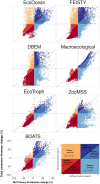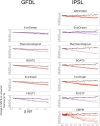Trophic amplification: A model intercomparison of climate driven changes in marine food webs
- PMID: 37611010
- PMCID: PMC10446190
- DOI: 10.1371/journal.pone.0287570
Trophic amplification: A model intercomparison of climate driven changes in marine food webs
Abstract
Marine animal biomass is expected to decrease in the 21st century due to climate driven changes in ocean environmental conditions. Previous studies suggest that the magnitude of the decline in primary production on apex predators could be amplified through the trophodynamics of marine food webs, leading to larger decreases in the biomass of predators relative to the decrease in primary production, a mechanism called trophic amplification. We compared relative changes in producer and consumer biomass or production in the global ocean to assess the extent of trophic amplification. We used simulations from nine marine ecosystem models (MEMs) from the Fisheries and Marine Ecosystem Models Intercomparison Project forced by two Earth System Models under the high greenhouse gas emissions Shared Socioeconomic Pathways (SSP5-8.5) and a scenario of no fishing. Globally, total consumer biomass is projected to decrease by 16.7 ± 9.5% more than net primary production (NPP) by 2090-2099 relative to 1995-2014, with substantial variations among MEMs and regions. Total consumer biomass is projected to decrease almost everywhere in the ocean (80% of the world's oceans) in the model ensemble. In 40% of the world's oceans, consumer biomass was projected to decrease more than NPP. Additionally, in another 36% of the world's oceans consumer biomass is expected to decrease even as projected NPP increases. By analysing the biomass response within food webs in available MEMs, we found that model parameters and structures contributed to more complex responses than a consistent amplification of climate impacts of higher trophic levels. Our study provides additional insights into the ecological mechanisms that will impact marine ecosystems, thereby informing model and scenario development.
Copyright: © 2023 Luzinais et al. This is an open access article distributed under the terms of the Creative Commons Attribution License, which permits unrestricted use, distribution, and reproduction in any medium, provided the original author and source are credited.
Conflict of interest statement
The authors have declared that no competing interests exist.
Figures








References
-
- IPCC. Observations: Ocean Pages. Climate Change 2013—The Physical Science Basis, Cambridge: Cambridge University Press; 2014, p. 255–316. doi: 10.1017/CBO9781107415324.010 - DOI
-
- Bindoff NL, Cheung WWL, Kairo JG, Arístegui J, Guinder VA, Hallberg R, et al.. Changing Ocean, Marine Ecosystems, and Dependent Communities. Marine Ecosystems 2019:142.
-
- Poloczanska ES, Burrows MT, Brown CJ, García Molinos J, Halpern BS, Hoegh-Guldberg O, et al.. Responses of Marine Organisms to Climate Change across Oceans. Front Mar Sci 2016;3. 10.3389/fmars.2016.00062. - DOI
Publication types
MeSH terms
LinkOut - more resources
Full Text Sources
Miscellaneous

